
By Jim Dunn, Professor of Agricultural Economics, Penn State University Market Psychology
Cheese and butter prices have increased by 5% in the past month, while the powdered product prices have dropped almost 5%. Non-fat dry milk prices are down 2.3%, while dry whey is down 4.7%. The dollar's value is down somewhat, with the euro and Australian dollar up 2.9% and 4.6%, respectively, while the New Zealand dollar fell 0.8%. Perhaps the gains in the dollar recently overestimated the differences between our economy and those of the other countries. The fighting in Eastern Ukraine has calmed down, although Russia continues to rattle its saber and foment trouble. The stronger dairy prices also reflect a reduction in the growth of milk production, which will help keep our production surpluses more in line with our export sales. The news for dairy markets has been largely negative recently, although the drought in New Zealand continues to hurt its milk production. The drought, combined with the lower world dairy prices, is hurting the New Zealand economy overall. New Zealand prices fell 3.5% in the latest Global Dairy Trade auction. Dairy is New Zealand's largest single export category and the dairy sector generates a significant share of the country's gross domestic product.
Table 1 lists some past and estimated future milk prices. I estimate the April Pennsylvania all-milk price to be $18.04/cwt, up $0.26 from March. The dairy futures market prices for Class III and IV show higher prices in the rest of 2015. The April Class III price was up $0.25 from March at $15.81/cwt. The latest Class III futures prices for the rest of 2015 average $17.22. The April Class IV price was down $0.29/cwt. from March at $13.51/cwt. The Class IV futures prices are higher for the remainder of 2015, averaging $15.58 for the next 8 months. My forecast for the average Pennsylvania all-milk price for 2015 is $19.23/cwt., which is $6.41/cwt. below 2014.
The strong U.S. dollar continues to challenge U.S. exporters of dairy products, although the Euro and Australian dollar have strengthened. Dairy exports have fallen significantly since their highs of midyear 2014, as the strong dollar, the weaker Chinese economy, and the Russian embargo all are hurting US exports.
Corn and Soybean Markets
Corn and soybean meal markets have weakened, as the strong dollar and weaker world economy are hurting these exports as well. The South American corn and bean crops, China, and the strong dollar continue to hang over U.S. markets, but these factors are essentially the same as a month ago. Corn planting in the Corn Belt is progressing very well and expectations are that this will be a very large crop with another year of low prices.
Income over Feed Costs (IOFC)
Penn State's measure of income over feed costs rose by 5% in April, as milk prices rose and feed prices fell. Figure 1 shows how these values compare to recent years. April's feed cost is 10¢/cow/day less than in March. April's value for IOFC of $6.47/cow/day is well below the 2014 values, when milk prices were very high and feed prices were moderate. The large drop in the milk price is the driver of the lower IOFC, although feed costs are slightly higher than the average for 2014.
Income over feed cost reflects daily gross milk income less feed costs for an average cow producing 65 pounds of milk per day. Figure 1 and Table 2 showing the monthly data follow.
The allocation of the revenue per hundred pounds of milk (milk margin) is shown in Table 3. The milk margin is the estimated amount of the Pennsylvania all milk price that remains after feed costs per hundredweight of milk production are paid. Like income over feed cost, this measure shows that the April PA milk margin was 5% higher than in March.
Milk Production
The latest milk production report showed March milk production up 1.2% from a year earlier, continuing the slowing growth of the recent months (Figure 2). Given the lower milk price and income over feed cost, this is a logical response to market conditions. The monthly cow numbers are shown in Figure 3. The March cow numbers fell by 0.05%. Together these two measures indicate that the dairy farmers are reacting to the poorer prices and prospects by reducing production.
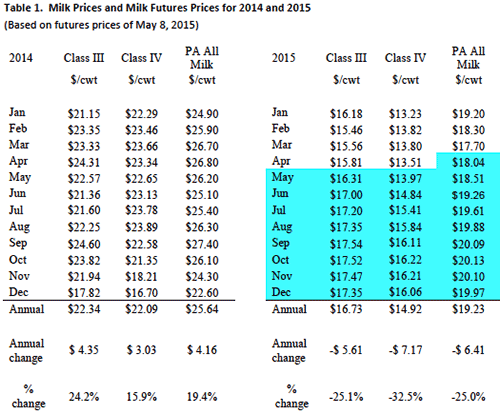

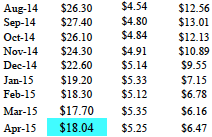
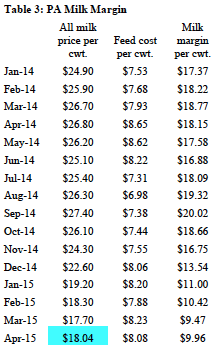
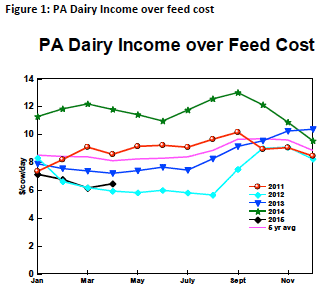
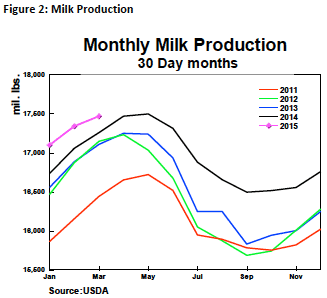
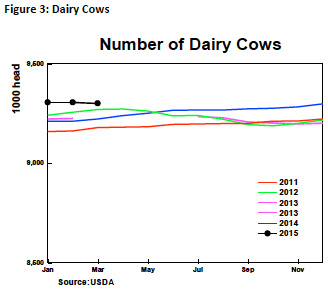
5.12.2015